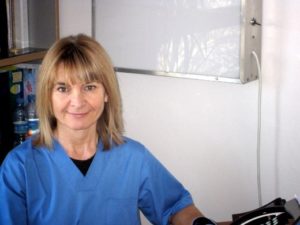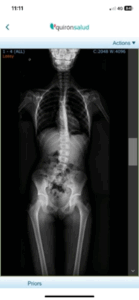In my 35 years of clinical practice, I’ve tried to explain to all our patients why chiropractic, a complementary and alternative medicine, goes beyond back pain and helps maintain optimal health.
I often make a comparison between dental and spinal health.
About 60 years ago, when I was a child, hardly anyone went to the dentist, unless they had a severe toothache, which was resolved by extracting the ‘damaged’ tooth.
Unfortunately, most people over 60 ended up with very few teeth. This not only affected their aesthetics, but also their nutrition, as they couldn’t chew properly and their health deteriorated.
Fortunately, we’ve learned that if we maintain good hygiene, by brushing our teeth after every meal, and go to the dentist from a young age for regular checkups and cleanings, we can keep all our teeth until the end.
Did you know that healthy adults have 32 teeth and also 32 vertebrae?
Maybe it’s a coincidence, maybe not. In any case, while a tooth can be easily replaced with an implant, a vertebral segment cannot be replaced.
It is true that there are artificial intervertebral disc implants and surgical procedures called arthrodesis, which are used to fix “damaged” vertebrae, but it would be much better not to need them.
Three reasons to have a chiropractic checkup and treatment of your spine, even if you don’t have back or neck pain:
First reason: Correction of cervical lordosis increases blood circulation to the brain.
A research study, published in 2019 in the prestigious journal ‘Brain Circulation’, showed that after chiropractic treatment to correct cervical lordosis, blood flow to the brain immediately increased by up to 225.9%.
https://pmc.ncbi.nlm.nih.gov/articles/PMC6458772/#__ffn_sectitle
The authors used Magnetic Resonance Angiography (MRA). This is a diagnostic test that uses color to map the brain’s blood supply areas.
Immediately after the chiropractic adjustments, a ‘burst’ of red was observed, signifying a large increase in cerebral blood flow.
Therefore, by correcting vertebral alignment and improving cervical lordosis, the vertebral arteries are decompressed. These arteries rise through the transverse foramina of the cervical vertebrae C6 – C1 while the internal carotid arteries are contained in the carotid sheath, that originates just in front of the third cervical vertebra (C3).
 There is one carotid artery on each side of the neck, and each divides into two branches. The inner branch carries blood to the brain and eyes, and the outer branch carries blood to the face, tongue, and external parts of the head.
There is one carotid artery on each side of the neck, and each divides into two branches. The inner branch carries blood to the brain and eyes, and the outer branch carries blood to the face, tongue, and external parts of the head.
Due to incorrect posture while using mobile phones, computers, and/or tablets, almost all children, adolescents, and adults experience rectification and even inversion of the cervical lordotic curve.
In the x-rays of some of our young patients we have found a significant inversion of the lordosis.
Correction of cervical lordosis is achieved by adjusting the vertebrae with specific chiropractic techniques and postural exercises.
If left untreated, in addition to early osteoarthritis and neck, shoulder, and/or arm pain, the patient will experience decreased blood flow to the brain. Symptoms that often appear include headaches, lack of attention and concentration, insomnia, etc.
Evidently, over the years, decreased blood flow to the brain leads to dizziness, memory loss, dementia, and other pathologies related to brain degeneration.
How can I tell if I or my children have cervical lordosis rectification?
By getting a chiropractic spinal checkup as soon as possible.
Second reason: Prevent scoliosis in children and osteoarthritis in adults
Most cases of scoliosis are functional and compensatory. This means that the spine twists in response to asymmetrical muscle tension.
These tensions are usually due to the practice of asymmetrical sports such as soccer, tennis, golf, basketball, handball, volleyball, etc.
These sports involve thousands of repetitions of movements performed with the dominant leg or hand.
Scoliogram – 12-year-old girl, soccer player
Furthermore, during childhood and adolescence, children usually experience many falls, which may seem unimportant since pain passes quickly. However, the sacroiliac joints frequently misalign or lock and the pelvis twists.
Pelvic dysmetria often occurs, making one leg appear shorter. Instead of adjusting the sacroiliac joints to restore pelvic and leg alignment, people often use insoles with a lift to correct the short leg. This can be a mistake! Unless it’s an anatomical dysmetria (a shorter bone due to a congenital or acquired defect), the lift will increase the likelihood of developing thoracic scoliosis.
Another causal factor of scoliosis, very common during adolescence, is dental malocclusion and orthodontics, when not accompanied by periodic vertebral adjustments:
https://www.angelaolaru.com/?s=dientes+escoliosis
During rapid growth, ligaments and tendons are very flexible, so any spinal biomechanical imbalance, whether induced by pelvic dysmetria or by correction of malocclusion through orthodontics, can twist the spine.
Orthodontic treatment for adolescents typically lasts about two years, just as they experience rapid growth.
As the teeth gradually straighten, the dental contacts slowly shift and the masticatory muscles continue to contract asymmetrically.
This asymmetry descends into the spine and twists the vertebrae, causing scoliosis.
The only way to prevent this is through regular checkups and chiropractic spinal adjustments to realign the vertebrae.
Third reason: Boost immunity
A study published in 2010 showed that a single vertebral adjustment increases interleukin-2 (IL-2) – induced antibody synthesis:
Interleukin-2 (IL-2) is a cytokine produced by T lymphocytes that plays a crucial role in the activation and proliferation of the immune system.
Don’t wait until you experience symptoms. Regular chiropractic checkups are key to maintaining a healthy spine and preventing future problems, at any age.




Recent Comments